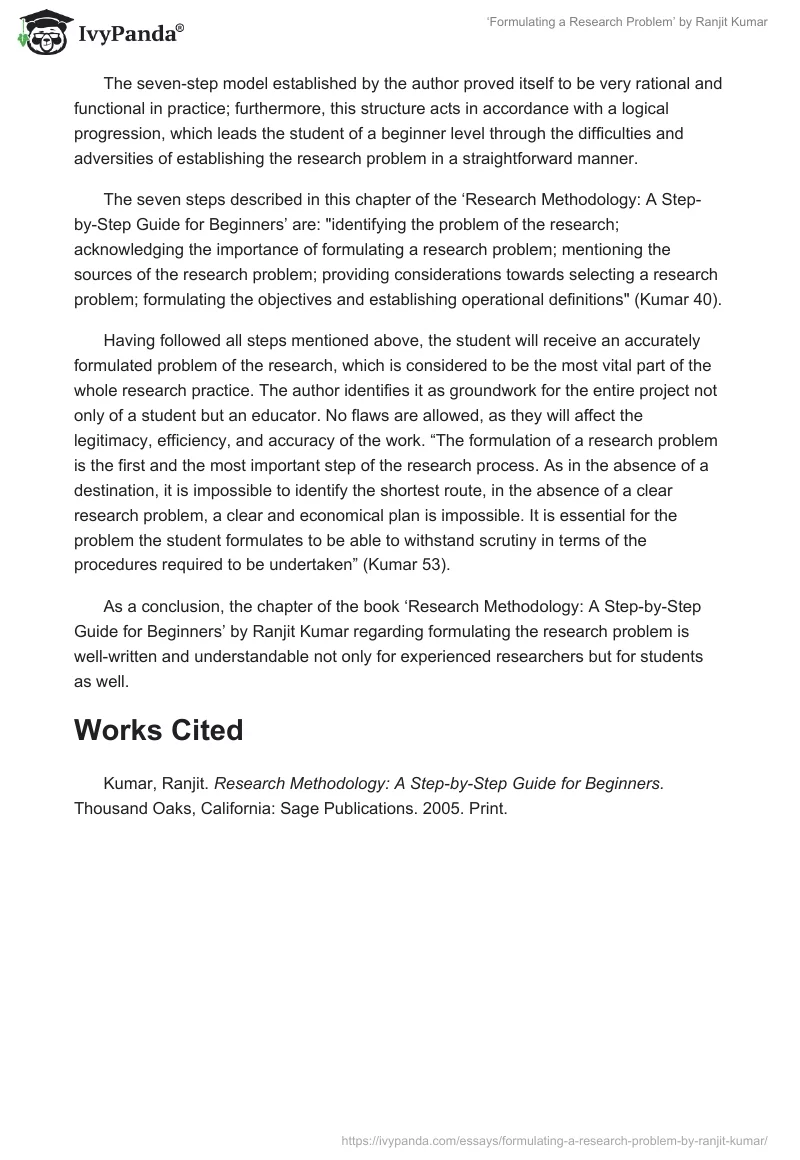How to Formulate a Research Problem
The book ‘Research Methodology: A Step-by-Step Guide for Beginners’ by Ranjit Kumar had been written expressly for the students who had never had any knowledge of research and its methodology. The book is composed of a compelling and reachable approach; moreover, it provides applicable methods and examples. The book helps to divide the designing practice and the process of a project researching into several convenient and simple stages. “The book is essential reading for undergraduate and postgraduate students in the social sciences embarking on quantitative or qualitative research projects” (Kumar 40).
The aim of this essay is to provide a review for one chapter of the ‘Research Methodology: A Step-by-Step Guide for Beginners’ – ‘Formulating a Research Problem’. The primary goal of this section of the book is to provide a detailed description of the process of defining the needed issue. According to the author, the particular course of actions that might occur during the formulation of the research problem depends on various factors. These are: “the expertise in research methodology of the reader, his knowledge of the subject area, the understanding of the issues that are to be examined by the reader, and the extent, to which the focus of the student’s study is predetermined” (Kumar 41).
Moreover, Ranjit Kumar focuses the attention of the students without any researching experience on following the steps that are described in the chapter in the exact same order. On the contrary, students with specific ideas about the problem formulating may want to use the methods that require less time than the processes for the beginners. Nonetheless, the author gives exceedingly accurate and comprehensive instructions towards identifying the research problem as he “assumes that the student has neither the required knowledge of the process of formulating a research problem nor a particular idea about what is to be researched” (Kumar 41).
The seven-step model established by the author proved itself to be very rational and functional in practice; furthermore, this structure acts in accordance with a logical progression, which leads the student of a beginner level through the difficulties and adversities of establishing the research problem in a straightforward manner.
The seven steps described in this chapter of the ‘Research Methodology: A Step-by-Step Guide for Beginners’ are: “identifying the problem of the research; acknowledging the importance of formulating a research problem; mentioning the sources of the research problem; providing considerations towards selecting a research problem; formulating the objectives and establishing operational definitions” (Kumar 40).
Having followed all steps mentioned above, the student will receive an accurately formulated problem of the research, which is considered to be the most vital part of the whole research practice. The author identifies it as groundwork for the entire project not only of a student but an educator. No flaws are allowed, as they will affect the legitimacy, efficiency, and accuracy of the work. “The formulation of a research problem is the first and the most important step of the research process. As in the absence of a destination, it is impossible to identify the shortest route, in the absence of a clear research problem, a clear and economical plan is impossible. It is essential for the problem the student formulates to be able to withstand scrutiny in terms of the procedures required to be undertaken” (Kumar 53).
As a conclusion, the chapter of the book ‘Research Methodology: A Step-by-Step Guide for Beginners’ by Ranjit Kumar regarding formulating the research problem is well-written and understandable not only for experienced researchers but for students as well.
Works Cited
Kumar, Ranjit. Research Methodology: A Step-by-Step Guide for Beginners. Thousand Oaks, California: Sage Publications. 2005. Print.


